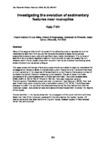Investigating the evolution of sedimentary features near monopiles
| dc.contributor.author | Firth, K. | |
| dc.date.accessioned | 2020-10-10T19:12:27Z | |
| dc.date.available | 2020-10-10T19:12:27Z | |
| dc.date.issued | 2020 | |
| dc.identifier.citation |
Firth, K. (2020) ‘Investigating the evolution of sedimentary features near monopiles’, The Plymouth Student Scientist, 13(1), p. 203-237. | en_US |
| dc.identifier.uri | http://hdl.handle.net/10026.1/16511 | |
| dc.description.abstract |
Many of the large windfarms off the coast of the UK are founded on sandbanks and the movement of sediment from around the monopile foundations leave the structures susceptible to severe scour pits and significant scour wake downstream. The removal of sediment not only has a negative impact on the structures but also the cables that run between each turbine. Areas of sediment accretion can cause localised overheating while areas of erosion can cause early fatigue. The paper presents findings of laboratory experiments completed to begin to understand the propagation of the scour wake in unidirectional current flow conditions. It is found that there is much variability in the response of the sediment to current flow but there are a number of consistent trends with tests of increasing current speeds. The same experiment was completed for 6 current speeds over a mobile sediment bed. The current speeds were 0.230, 0.201, 0.187, 0.178, 0.175 and 0.149 m/s. Flow was measured using an Electromagnetic Flow Meter suspended over the sediment bed (Valeport, 2019). Each test was filmed using aerial projection and a compilation video (Firth, 2019). The footage was analysed to obtain the results of the distances travelled by the disturbance front and the individual ripples. Data collection also took place after each experiment to collect the heights of the ripples. Trends identified in the results show that: the propagation of the ripple field front is 4 times faster than that of the individual ripples within the disturbance; the ripples migrate in 2 distinct paths and they take the form of linguoid ripples, however appear in heart shapes rather than semi-circular. | en_US |
| dc.language.iso | en | en_US |
| dc.publisher | University of Plymouth | en_US |
| dc.rights | Attribution 3.0 United States | * |
| dc.rights.uri | http://creativecommons.org/licenses/by/3.0/us/ | * |
| dc.subject | evolution of sedimentary features | en_US |
| dc.subject | monopiles | en_US |
| dc.subject | engineering | en_US |
| dc.subject | sandbanks | en_US |
| dc.subject | windfarms | en_US |
| dc.subject | scour pits | en_US |
| dc.subject | scour wake | en_US |
| dc.subject | ripple field front | en_US |
| dc.subject | ripples | en_US |
| dc.title | Investigating the evolution of sedimentary features near monopiles | en_US |
| dc.type | Article | en_US |
| plymouth.issue | 1 | |
| plymouth.volume | 13 | |
| plymouth.journal | The Plymouth Student Scientist |



